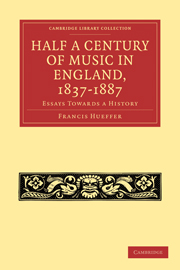CHAPTER V - CONCLUSION
Published online by Cambridge University Press: 29 August 2010
Summary
Not many weeks ago I had a conversation with a young English composer in whose future I have, in spite of many disappointments, a singularly firm belief, provided always that he can keep clear of the rocks of commonplace and popularity in the bad sense of the word, to which festival committees, publishers, and other sirens lure the aspiring musician. I was exceedingly struck by the emphatic manner in which my young friend held fortli against so-called “absolute” music. The Symphony, the Sonata, and other classical forms appear to him to be the effete types of a bygone age. A piece of music without a subject, he thought, was as meaningless as a picture without a subject. In short, he expressed the most unqualified allegiance to that “poetic idea in music” which Wagner, Liszt, and Berlioz have proclaimed in their various ways.
With this thorough-going revolutionism I was, of course, unable to agree in all its bearings. Ripe experience has taught me that in the house of music there are many habitations, that the classical form created by Haydn, and imbued with infinite varieties and depths of beauty by Mozart, Beethoven, Schumann, Mendelssohn, and many others, is by no means obsolete; that in the hands of genius it may still bring forth rich and noble fruit. Neither can I admit that music must necessarily deal with an extraneous subject; even painting may to a certain extent dispense with such a subject, may become a vague and delightful harmony of colour, as Turner and Mr. Whistler have taught us. Much more so is this the case in the art of sounds.
- Type
- Chapter
- Information
- Half a Century of Music in England, 1837–1887Essays Towards a History, pp. 235 - 240Publisher: Cambridge University PressPrint publication year: 2009First published in: 1889

